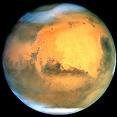 Close Topic Options
Close Topic OptionsMars - Page 5 of 9
NASA scientists discover unexpected mineral - Page 5 - Sciences, Education, Art, Writing, UFO - Posted: 23rd Jun, 2016 - 11:00am
Mars - Page 5
NASA scientists say they believe they have confirmed that water intermittently flows on the surface of Mars, a discovery that may have ramifications in the search for past or present life on the planet.
Researchers have known for many years that Mars has water frozen at its poles, in its thin atmosphere, and, most recently, in tiny puddles that appear to form at night on the surface. But flowing water is a big development, NASA said.
"This is a significant development, as it appears to confirm that water -- albeit briny -- is flowing today on the surface of Mars," Said John Grunsfeld, astronaut and associate administrator of NASA's Science Mission Directorate in Washington. Ref. CNN
Mars
Rare transit of Mercury to take place on 9 May
On 9 May there will be a rare transit of Mercury, when the smallest planet in our Solar System will pass directly between the Earth and the Sun. The last time this happened was in 2006, and the next two occasions will be in 2019 and 2032. During the transit, which takes place in the afternoon and early evening in the UK, Mercury will appear as a dark silhouetted disk against the bright surface of the Sun. Ref. Source 7k.
Mars
Hubble takes Mars portrait near close approach
On May 12, 2016, astronomers using NASA's Hubble Space Telescope captured this striking image of Mars, when the planet was 50 million miles from Earth. The photo reveals details as small as 20 miles to 30 miles across. This observation was made just a few days before Mars opposition on May 22, when the sun and Mars will be on exact opposite sides of Earth, and Mars will be 47 million miles from Earth. Ref. Source 2l.
Mars - Page 5
CaSSIS sends first image of Mars
The Mars Camera CaSSIS on the ExoMars Trace Gas Orbiter captured its first images of the Red Planet this week. The pictures are a part of the mission’s preparations for arriving at its destination in October. CaSSIS (Colour and Stereo Surface Imaging System) was launched with the European Space Agency’s ExoMars Trace Gas Orbiter (TGO) in March and has already traveled just under half of its nearly 500 million km journey. Ref. Source 4p.
 TOPIC: Mars
TOPIC: Mars Getting to Mars - Terra Forming - Getting to Mars from Earth
Getting to Mars - Terra Forming - Getting to Mars from Earth